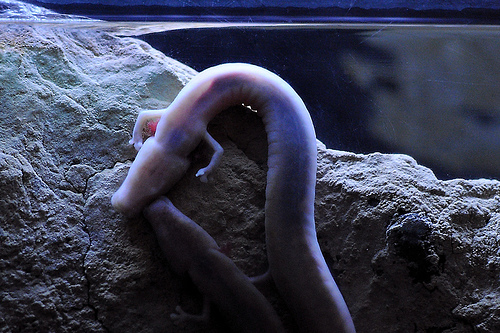Olms are not aliens from another dimension, but they certainly look strange!
- Olms are amphibious animals that live in underwater cave habitats in Europe’s central and south-eastern areas.
- An ‘olm’ is also known as a ‘proteus’, ‘cave salamander’ and a ‘human fish’, due to the animal’s colour being similar to European human skin colour.
- The olm has the scientific name Proteus anguinus and comes from the family Proteidae, a family of aquatic salamanders, and the animal is the only living member of the Proteus genus.
- Olms range in lengths from 2.5 to 40 centimetres (1 to 16 inches) and weigh between 2 and 150 grams (0.1 to 5.3 ounces).
- The colour of an olm can be white, pink or pale yellow, due to the lack of colour-inducing chemicals in the animal’s skin, and while it looks somewhat similar, it is only distantly related to the axolotl.
 Olm
Olm
Image courtesy of SanShoot/Flickr
- Olms have short frilly gills; a long eel-like body, that moves in similar ways; as well as four small legs, while the back legs have two digits and the front have three.
- Most olms lack visible eyes, as they are covered with skin, and they sense their surroundings using receptors, as well as relying on hearing and smell.
- Full maturity does not occur until olms are 10 years old or more, and females lay between 5 and 70 eggs at a time, deposited among rocks, after which the eggs hatch into roughly 2 centimetre (0.8 inch) long tadpoles.
- While olms are protected in some countries and have few predators, they are classified as vulnerably endangered and are threatened by man-made chemicals seeping into the water.
- Olms have a diet that mainly consists of worms, snails and insects, although they are said to be able to live without food for ten years, and they have a lifespan of up to 50 years or more.
Bibliography:
Olm, 2014, A-Z Animals, http://a-z-animals.com/animals/olm/
Olm, 2014, Wikipedia, http://en.wikipedia.org/wiki/Olm






